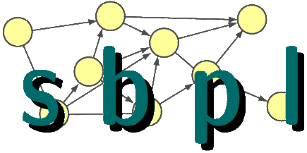SBPL overview
This tutorial will describe how SBPL is set up.
Environments As described in the previous tutorial, planning with search-based methods have two parts - representing the problem as a graph, then solving the graph with graph-search methods. SBPL has two objects it uses for these two roles - the environment and the planner. Unless you're fiddling with the actual graph search algorithm, the environment object will be the thing you interact most with. In a nutshell, the environment handles domain specific details and translates them into a generic form for the planner to handle. For example, the environment handles the translation between the (x, y, theta) position of a robot into a graph composed of generic state IDs. The planner then solves the graph without having to know about the domain. (This doesn't actually happen in one step - the graph is generated on demand by the planner. As a result, the planner often calls the environment object to retrieve information on demand). The environment also implements the heuristic computation. This is domain dependent, since the heuristic for guiding a robotic arm to an object will be different from navigating a car close to its goal. There already exists many environments and planners in SBPL, but they might not cover a custom scenario. In this case, you will have to implement your own environment (a very involved topic that might be covered in the future). These can all be found in sbpl/src/discrete_space_information. Other environments that have successfully been implemented (but not included in SBPL): Planners There are a number of planners that are available in sbpl/src/planners
